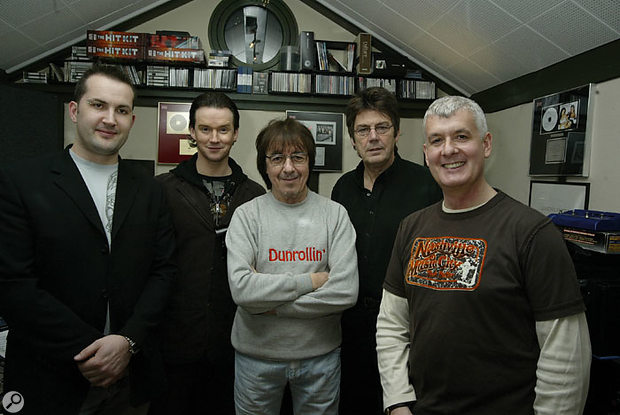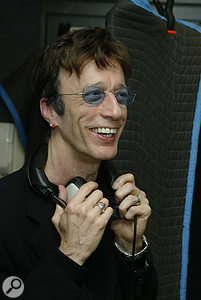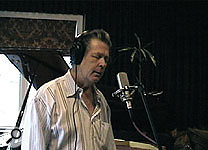 Russell Watson (second from left) and Bill Wyman (centre) both contributed their parts on the same day, in the studio of Steve Levine (far-right). Also present for this photo were keyboard player Darren Sell (left) and the song's author Mike Read (second right).
Russell Watson (second from left) and Bill Wyman (centre) both contributed their parts on the same day, in the studio of Steve Levine (far-right). Also present for this photo were keyboard player Darren Sell (left) and the song's author Mike Read (second right).
Celebrities from around the world were keen to contribute to a fund-raising single for victims of the Asian tsunami, and converting all of this goodwill into a finished record required innovative use of broadband Internet to collect together their performances.
On Boxing Day 2004 the world woke up to one of the worst natural disasters to hit this planet in years when an immense tsunami, caused by a massive earthquake, killed more than a quarter of a million people in Asia. For most of us, helping amounted to putting our hands in our pockets and donating to the appeal launched by the disaster relief charities. However, radio DJ and presenter Mike Read was so moved by the scenes unfolding on his television that he felt he had to do more.
The obvious vehicle to employ was a charity single that could be recorded and released quickly to maximise sales while the horror of the disaster was still fresh in the public's mind. As luck would have it, Read even had a song already written, 'Grief Never Grows Old', that he considered perfect for the role. The problem he faced was tracking down the right people to sing the song, and the right production team to make it happen. To get the ball rolling, he rang producer Steve Levine, because he knew that Levine had the two things the project needed: his own studio and the technical knowledge to pull the whole thing off.
"When Mike called me the day after Boxing Day, my immediate reaction was 'Yes, I want to do this,'" Steve Levine says. "Like everyone else I just wanted to do anything I could to help. I'd already heard the song; he'd played it to me some months ago, although at that time I didn't think there was much we could do with it because I couldn't think of an artist it might suit. But when he came round with the rough demo and I listened to it again, I realised it was perfect because it has such emotional lyrics and it really summed up what we were all feeling."
Good Connections
As producer, Steve Levine's role included getting artists involved in the project. Mike Read's rough demo really was rough, but the people Levine approached were willing to see beyond this and to put their faith in his ability to turn out a worthwhile track. The problem was how to make it possible for them to contribute. "Thank God for the Internet!" says Levine. "If it wasn't for broadband, we'd have been stuffed because the people we wanted were scattered all over the world and there was no hope of getting them all together in one place. What we ended up doing was technically so clever that I honestly don't think we could have done this even six months ago. It's only the most recent advances in Internet technology that have made this possible — that and the fact that everyone we approached was so willing to help." All those taking part around the world were asked to film their performances for inclusion in the accompanying video.
All those taking part around the world were asked to film their performances for inclusion in the accompanying video.
As Cliff Richard was on holiday in Barbados, Levine's first thought was to stick him in Eddie Grant's studio and record him there. But by then Cliff had to go to the US, so John Fara and Peter Wolf helped out by recording Cliff's vocals in their Los Angeles studios. These were sent back to London via the Internet. "At this point, Mike realised that technically it was going to be possible to get lots of other people involved," Levine explains. "So we both hit the phones and began ringing everyone we could think of who might be prepared to take part."
Once news of the project went public, mainly thanks to Sky TV, it didn't take long for people to start calling, and the list eventually came down to the following: Boy George, who was in New York; Barry Gibb, in Miami; Gerry Beckley & Dewey Bunell (of the band America), both of whom were in Southern California; Jon Anderson, Northern California; Brian Wilson, also in California; and Russell Watson, who was in London — as were Steve Winwood, Robin Gibb, backing vocalist Celena Cherry, Bill Wyman, who played bass, and Gary Moore, who was responsible for the guitar solo. Additional instrumental parts were provided by Davy Spillane, who was in Southern Ireland and was the only artist who couldn't access broadband.
Kicking Off
Once the impressive range of guest stars had been recruited (see box), Levine began by sketching out a rough backing track with keyboard player Darren Sell. He wanted to take a soundtrack approach to the project and to incorporate ethnic percussion rather than a full drum sound that would drown out the vocals. "I had a couple of loops that I used on the backing track — a wave drum from Stylus RMX and a shaker I'd put in myself," he explains. Bill Wyman's bass part was the first celebrity contribution to be recorded.
Bill Wyman's bass part was the first celebrity contribution to be recorded.
Those artists who were recording their own contributions were initially sent four items: the original demo, a Read Me file explaining how Levine wanted their performances recorded and what formats to use, a mono guide vocal mapped out by session singer Sam Blue and a stereo backing track. These were initially sent as MP3 files, and Levine also made AIFF and SDII files available for performers to download, containing the stereo cue mix of the backing track, and in some cases additional vocal cues where it was important that two vocal elements worked together. The majority of those taking part were using Pro Tools, while a few used Logic and one or two used Digital Performer. Full-quality files were stuffed and Binhexed to compress them without losing data, prior to being uploaded onto Levine's own web server by individual artists.
"We gave each artist full creative freedom to interpret the track as they saw fit," Levine says. "They sent back their parts as files, some of which were huge. If they wanted to do their own vocal comps, then that was fine. All these people were working with exceptional producers and engineers who knew how to comp properly, so we asked them to send what they were happy with."
The London end of the recording was carried out in Levine's own studio. First in was Bill Wyman, who did the bass in three takes. "He was amazing," says Levine. "He'd only heard the song that day but he gave us everything we needed with no hassle at all. We cut the best bits from each take, did a couple of punch-ins and we had it."
 Russell Watson's voice was earmarked for the first verse.
Russell Watson's voice was earmarked for the first verse.
From the outset, Levine had a clear idea of who was to sing what. The first verse was always going to be Russell Watson's because his vocal style lent itself to the lines. Steve Winwood was to take the second verse, Cliff Richard the third, and Robin Gibb the fourth. However, when Barry Gibb agreed to take part, Levine revised his plan so that he could incorporate plenty of Barry's classic vocal sounds. "He told me exactly how he got his sound, which basically involves a lot of multitracking and reverb," Levine says. "When his vocals came through they were so beautiful and so well recorded that they blew me away. I kept some of Cliff's lines in verse three and used them around some of Barry's. The song jumps between the two voices, which works really well." Robin Gibb of the Bee Gees was an early recruit to the project, and was later joined by brother Barry.
Robin Gibb of the Bee Gees was an early recruit to the project, and was later joined by brother Barry.
Some of the artists recorded the entire song, giving Levine the option of picking particular lines. Levine says: "I was looking for the vibe with everyone's contribution and working out what fitted where and what fitted in with my original plan. Gerry Beckley sent me the whole song and some of his lines just jumped out at me so I knew exactly where to use them. Dewey Bunell was in Culver City where Hank Linderman has a studio, so they worked together on his vocals and I used them alongside Gerry's because that's what everyone wants to hear — their voices together. Then Jon Anderson sent us a load of stuff from North California, and by incorporating his high voice we were able to give the track an ethereal quality.
"All we needed was Brian Wilson's vocal, so Hank went up to his home with a laptop and recorded him on that. This was great because it gave us the classic Beach Boys sound that Brian is known for. He did four takes and also did a video at the same time, which is what we'd asked everyone to do because we wanted to use the footage on the promo."
Coming Together
Throughout this process, Levine was constantly uploading and downloading material, using his office computer as a hub and then transferring files on to his G4 in the studio to work on them there.
"Once we had all the vocals, I realised there were a few parts I wanted to change and more instruments I wanted to add. I was keen to use Gary Moore, so I sent him a rough mix by email because he was away on holiday and when he got back he came into the studio and nailed the guitar solo. He played it through a small amp in my conservatory and it worked so well that I'll definitely try that again."
Levine also used Davy Spillane for Irish flutes and panpipes. The backing track and original demo were sent to Ireland via UPS and Spillane sent his contribution back the same way. "This was the last element to arrive," says Levine. "It came through just in time for the mix. We also had to wait for Boy George because there was a last-minute change of studio. It was still done in New York, but at Radio Studio because George was recording an interview there."
Although Levine wasn't working to a fixed deadline, the track needed to be completed quickly so that it could be released as soon as possible. Mastering time, donated by Alchemy Studios in London, was booked for Wednesday January 12th and Levine met that deadline by working flat out during the preceding week. "I started recording on January 5th and was ready to mix by the 12th. Everyone was coming on line at different times, so I was staying up quite late — although not ridiculously late because it's important to get enough sleep when you tackle something as complex as this, otherwise you end up making mistakes and deleting files you need. I was in bed by one am most nights, after I'd made sure all my uploads had got through to LA. Then in the morning I'd come down early and there would be all this stuff on the computer — rough edits and vocals that I could stick onto the master later in the day. It was a fantastic effort by everyone. We used iChat as well. On one occasion we had Steve Winwood hooked up with Hank while he was recording Foskett and Randell's backing vocals so they could see each other performing and get a vibe going.
"My studio computer couldn't cope with the number of tracks involved, so Mike Munn at Apple UK lent me another to give me more processing power. At one stage, when I was sorting out the harmony and needed to hear everything, I had 112 tracks open at the same time. My [Yamaha] DM2000 was a Godsend. It's fully loaded with ADAT cards, so with 96 inputs there were plenty of returns available, and I have the RME Hammerfall MADI card in my Mac, sending 64 outputs to the DM2000 via RME's MADI-to-ADAT converter. During the recording process I had help from Darren Sell and Rob May who edited Bill Wyman's bass. Rob and I exchanged Logic files over the Internet because we were using the same audio source, so once I loaded in his file all his cuts came up. And sending the files back and forth by email was easy because they were no bigger than a Word document.
"Once I had everything down, I was ready to mix on my DM2000. The process was straightforward as all the settings had been stored as snapshots as I went along, so all I had to do was recall them."
The Wonders Of Broadband
Using the Internet to send material back and forth helped keep costs down to a minimum as virtually everyone involved already had broadband. "This project wouldn't have been possible without broadband because it would have taken too long to upload and download files," Levine says. "The way this track was put together opens up real creative possibilities for the future. Artists wanting to collaborate no longer need to be in the same building and the cost of moving audio from one studio to another — even from one continent to another — becomes minuscule when everyone has broadband.
"From my own point of view, it wasn't technically complicated because I've been doing this type of work for a long time and I'm very comfortable with computers. But for some of the artists involved it was a big learning curve and they took a lot of new skills from the project. Once we talked everyone through what we wanted and got them to invest in a $20 shareware package called Fetch, we were off. The range of studios everyone was using was incredibly diverse — from a basic Pro Tools setup with a laptop through to massive studios that have cost their owners a fortune. But the quality of the recordings was phenomenal, regardless of where they were done. Working with experienced people helped. I didn't get any poor-quality files or any terrible vocal performances. They were all spot-on. All I had to do was listen and decide what was going where. We deliberately didn't adopt a precise science approach to their creativity because we felt it was best to just let them do their own thing. The ideas, interpretations and vocal styles they came up with were incredible. When left alone to do what they felt worked, they all created something amazing — their signature style."
'Grief Never Grows Old' was released on January 24th on the One World imprint, with distribution through Universal.
